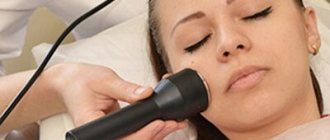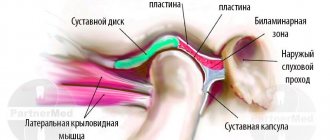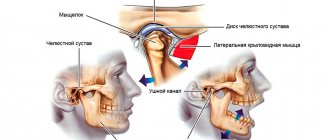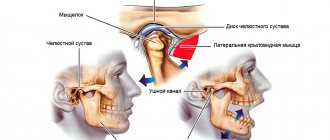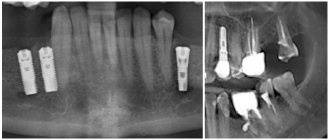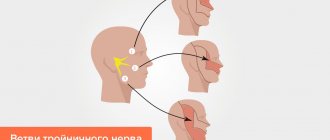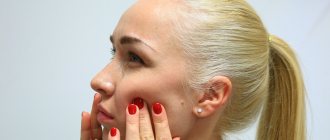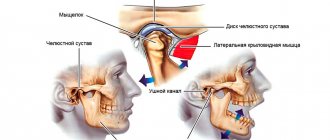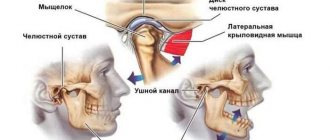Many of our patients (as well as patients, for example, of chiropractors or neurologists) do not even realize how interconnected the problems they are being treated with are. For example, the jaw joint hurts, the head hurts, shooting in the ear, clicking in the jaw, pulling at the base of the skull... it would seem that these are different symptoms, but the reason may be the same for everyone: TMJ dysfunction
.
Functions of the TMJ
TMJ
or
temporomandibular joint
is a joint located above the ear that connects the temporal bone to the lower jaw and the lower jaw to the skull. The muscles that are attached to this joint are actively involved in speaking, facial expressions, chewing, and swallowing. Together, muscles, ligaments, cartilage and joints make up the apparatus, thanks to which we can generally open and close our mouth, move our jaw back and forth and left and right, and the load on this apparatus is significant - comparable to the load, for example, on the knee joint.
The temporomandibular joint is the only paired and symmetrically moving joint in the human body, and problems with its functioning lead to numerous unpleasant diseases. TMJ dysfunction—limited work and mobility of the jaw joint—occurs when the joint on the right and left sides of the skull does not move synchronously or evenly. For example, to open the mouth, the patient must first move the lower jaw from side to side, “until it clicks.” Or when you open your mouth, you feel pain in your jaw or temples.
This disease has many names: arthritis (arthrosis) of the TMJ, myofacial syndrome, myoarthropathy of the TMJ, chronic dislocation of the lower jaw, Costen's syndrome (named after the American doctor who first identified this disease). This pathology is difficult to diagnose and treat, and at the same time it can cause a wide variety of pain - from headaches to neck pain.
Statistical fact: from 30% to 70% of dental patients suffer from functional pathology of the temporomandibular joint. And these are not always older people, as one might expect. On the contrary, people of all ages, including children, suffer from TMJ pain and related pain.
TMJ dysfunction was first described by otolaryngologist (ENT doctor) Kosten in 1934. Kosten studied pain and noise in the ears and burning in the nose, which intensified during or after eating, and was the first to think of linking them with malfunction of the temporomandibular joint. Subsequently, his colleagues and other doctors who examined this problem expanded and supplemented the list of symptoms. Now this list is quite extensive, and often not all symptoms can be associated specifically with TMJ problems.
Treatment of pathology of the temporomandibular joint (TMJ)
The temporomandibular joint is a complex, paired joint on the skull that is responsible for the closure of the dentition and movement of the lower jaw.
Manifestations of TMJ pathology:
- Violations of facial symmetry, facial shape.
- Extraneous sounds when opening and closing the mouth (crunching, grinding, clicking).
- Inability to open mouth wide.
- Painful and unpleasant sensations in the temporomandibular joint when chewing or opening the mouth. The pain may spread to the masticatory muscles and to the head.
- severe headache
, dizziness, pain in the ears and neck. - Noise and feeling of fullness in the ears.
- Reactive enlargement of nearby lymph nodes.
- Pain in teeth when chewing food.
Why do TMJ diseases occur?
- Various injuries in the lower jaw.
- Long-term absence of chewing teeth.
- Adverse habits such as one-sided chewing, onychophagia (nail biting).
- Broken bite.
- Bruxism is the clenching of teeth, grinding or knocking of teeth. Occurs most often against the background of stress, mental or physical stress, or improper closure of teeth. As a result, the activity of the masticatory muscles increases, teeth wear down, joint damage occurs, and pain appears in the ears and masticatory muscles. If this process is not stopped, movement in the jaw becomes limited, and overstrain of the muscle corset of the neck and back occurs, leading to osteochondrosis of the spine, severe headaches, and
sleep disturbances. - Endocrine and infectious diseases.
- Other reasons.
The most common types of TMJ diseases:
Subluxation and dislocation of the TMJ occurs due to displacement of the articular surfaces relative to each other. It manifests itself as the inability to open the mouth strongly, pain, and extraneous sounds during movement in the joint (clicking).
Arthritis
temporomandibular
joint
. Arthritis is inflammation of a joint; there is acute and chronic arthritis. The acute course is characterized by fever, swelling, redness, pain and impaired mobility. In a chronic course, crunching in the TMJ and pain come to the fore; restrictions in the movement of the joint do not appear immediately, approximately by the third week of the disease. In advanced cases, TMJ deformity may appear.
Arthrosis is a progressive degenerative disease that leads to the gradual destruction of the cartilage tissue of the joint. Causes of occurrence: inflammatory phenomena in the TMJ, injuries, metabolic disorders. Arthrosis is manifested by characteristic movement disorders in the TMJ (zigzag movement of the jaw at the moment of opening the mouth), pain, and extraneous sounds when the joint works (clicking, crunching).
Ankylosis of the temporomandibular joint is immobility in the joint, resulting from infectious diseases and injuries. In severe cases, it can manifest as a violation of facial symmetry, malocclusion, multiple caries and lead to complete immobility of the TMJ.
Dysfunction of the temporomandibular joint is usually called various disorders in the system of the joint itself and the structures associated with it. This pathology is associated with various mental and endocrine disorders. TMJ dysfunction is characterized by facial asymmetry, pain and clicking in the joint itself, as well as in the temple and ear area on the affected side, and blocking of the lower jaw. If left untreated for a long time, it can lead to the development of arthrosis.
Diagnosis of pathology of the temporomandibular joint.
There is a test for self-diagnosis of TMJ dysfunction:
| № | Question | Yes | No |
| 1 | Do you have any extraneous sounds in the joint when you move your jaw? | 1 | 0 |
| 2 | Do you notice yourself clenching your jaw during the day or at night? | 1 | 0 |
| 3 | Can you open your mouth completely? | 0 | 1 |
| 4 | Do you have correct posture? | 0 | 1 |
| 5 | Do you experience pain in the TMJ? | 1 | 0 |
| 6 | Do you experience pain in your facial muscles? | 1 | 0 |
| 7 | Have you ever had fillings or crowns chipped? | 1 | 0 |
| 8 | Do you have problems with tooth sensitivity? | 1 | 0 |
| 9 | Are you bothered by ringing or noise in your ears? | 1 | 0 |
| 10 | Do you have worn teeth? | 1 | 0 |
| 11 | Have you noticed changes in the shape of your face? | 1 | 0 |
| 12 | Have you noticed changes in the position of your lower jaw? | 1 | 0 |
| 13 | Do you have fatigue in your masticatory muscles? | 1 | 0 |
If you score 2 or more points, you need to seek help from a specialist.
When examined by a doctor, the patient's breathing, swallowing, chewing, and posture are assessed. The specialist studies how the teeth close in different positions of the jaw and the condition of the masticatory muscles.
Instrumental methods for diagnosing TMJ pathology:
- Various options for radiographic examination (obtaining intraoral and extraoral images, orthopantomography, multislice computed tomography, teleradiography followed by cephalometry and other methods).
- Production of diagnostic jaw models.
- Manual functional analysis of the problematic joint.
- Electromyography, which determines the force of compression of the masticatory muscles.
Treatment of pathology of the temporomandibular joint
- Reducing the range of movements in the TMJ, a special diet, a set of exercises to relax the masticatory muscles.
- Drug treatment, this includes different options for anti-inflammatory and painkillers.
- Correction of the bite, restoration of the number of teeth, correct closure of the jaws.
- If necessary, intra-articular injections are prescribed.
- Washing the temporomandibular joint.
- Physiotherapy: electrophoresis, diadynamic currents and other methods, massage.
- Splinting is used to prevent teeth from closing together during sleep, to relax the masticatory muscles, and to prevent tooth decay during bruxism.
Author: K.M.N., Academician of the Russian Academy of Medical Sciences M.A. Bobyr
Symptoms of TMJ dysfunction
- Pain in the jaw, increasing when opening the mouth, chewing, speaking, yawning;
Clicking in the joint of the lower jaw, the jaw “jams”, it does not open, does not close, or has begun to close differently;- Pain in the temples, in the eye area, visual impairment, photophobia (sensitivity to light);
- Pain, ringing and noise in the ears, in the ear area, feeling of pressure in the ears;
- Frequent headaches, dizziness, migraines;
- Sleep disorders, insomnia, anxiety, depression;
- Pain in the neck, in the lower part of the skull;
- Tooth pain from sweets, hot, cold.
This diversity in symptoms, which often makes it difficult for doctors to diagnose, is explained by the fact that the joint is connected to many important organs and parts of the body (eyes, ears, neck, head) and errors in its functioning can affect everything at once, or they can only affect something one. It is usually possible to determine that the problem is in the temporomandibular joint only in a complex manner.
In most cases, TMJ dysfunction is manifested by pain in the face, joints of the jaw, neck, shoulders, ears, crunching and clicking. Complaints of dizziness, difficulty chewing food, speech and hearing disorders, difficulty opening the mouth, “jamming” of the jaw, or even the appearance of swelling and fever are also common.
Important points
The most common factors that provoke pain when opening the mouth are:
- Injuries. Mechanical damage is quite easily confused with manifestations of other dangerous ailments. Therefore, only a specialist can make an accurate diagnosis. There are several types of injuries: dislocation, jaw fracture, bruises. All these phenomena can cause pain when opening the mouth. Pathology can be eliminated only if the consequences of injuries are eliminated. In this case, patients are often prescribed surgical intervention.
- Purulent-inflammatory diseases. They affect the structure of bone tissue and are a typical cause of pain when opening the jaw. The most common representatives of these ailments are osteomyelitis, boils, and abscess. All of them are accompanied by the accumulation of a huge amount of pus in the gums and sharp pain in the jaw.
- Consequences of wearing braces. Such systems are prescribed to correct bites and eliminate other dental pathologies. They are quite effective and require long-term wearing. When used, many patients complain of some discomfort and pain when opening their mouth. Such phenomena are usually temporary and pass quickly. Similar symptoms can occur when installing removable dentures. If they do not disappear, you should immediately visit the dentist. Otherwise, dangerous consequences cannot be avoided.
- Neoplasms. They can be malignant or benign, and often cause pain when opening the mouth. The presence of tumors in the first stages occurs with mild symptoms; the patient may not even suspect that he has a tumor. With osteoma, the pain is not significant; it intensifies as the disease grows. Adamantioma has more pronounced symptoms; the disease is characterized by a significant enlargement of the jaw. This phenomenon causes severe discomfort when eating and talking. Only a specialist can distinguish a benign neoplasm from a cancerous tumor.
- Neuralgia. Discomfort may occur due to pinched nerves or inflammation. This pathology is accompanied by severe painful sensations that occur even during a period of rest and intensify when talking, eating, yawning, or blowing your nose. Such pathologies require immediate intervention by a specialist, otherwise the consequences may be irreversible.
Pain in the jaw joint: causes
- Defects in the dentition - lack of teeth, overestimation of fillings;
Pathological abrasion of teeth;- Broken bite
;
- Overload of the masticatory muscles (for example, if you chew on only one side for a long time);
- Inaccurate prosthetics, errors in orthodontic treatment;
- Other anomalies of the oral cavity and jaw structure;
- Bruxism, involuntary grinding of teeth.
- Birth trauma, trauma to the skull and jaw;
- Osteochondrosis and scoliosis of the spine;
- Severe constant stress
;
- An infection in the joint cavity that provokes inflammation of the TMJ.
Diagnostics and x-ray of the temporomandibular joint
Diagnosis of TMJ when it is dysfunctional is difficult due to the variety of clinical complaints. This leads to the fact that the patient can undergo examination by different specialists for a long time, wasting time. A full examination is carried out by dentists
(primarily an orthopedist or orthodontist) and neurologists.
Diagnosis with the naked eye is difficult, and TMJ problems can only be directly noticed if the malocclusion is clearly visible. Most often, dysfunction of the temporomandibular joint is associated precisely with disorders of bite and jaw closure.
The most reliable and effective way is to conduct x-ray diagnostics and orthopantomogram
jaws. In some cases, an MRI may also be done.
How to understand what is bothering you with TMJ: 4 obvious signs
If you feel discomfort while talking, chewing, or yawning, look out for these signs:
- Are there any clicks or popping sounds during jaw operation (only 20% of people who notice this symptom complain of pain, however, this is a reason to suspect arthrosis of the temporomandibular joint and go for a diagnosis);
- Is there a feeling of jamming of the joint (if the fossa and the articular head are not in perfect contact, you have to open your mouth as much as possible, trying to find the right point);
- How severe is the pain (can occur when chewing, radiate to the temples, under the tongue, ears, neck, sternoclavicular region);
- Has your general health changed (headache and dizziness, insomnia, hearing impairment, depression and other uncharacteristic manifestations are possible).
With TMJ dysfunction, some patients develop snoring
Treatment of the temporomandibular joint
Complex treatment of TMJ is possible only in dentistry, and is possible thanks to:
- surgery on the lower jaw;
- orthodontic treatment
(prescribing special trainers that will be worn at night and reduce pain by adjusting the load on the joint - the same trainers are recommended for bruxism) and bite correction with braces;
- orthopedic treatment
and
implantation
(insert a suitable prosthesis to restore the correct closure of the jaws).
Treatment is always prescribed individually, based on the results of an examination by an orthodontist, and is most often carried out comprehensively. It is dangerous to neglect TMJ diseases: this can lead to arthrosis, in which connective tissue grows in the joint cavity, which, in turn, threatens complete immobilization of the joint (ankylosis).
Severe pain and joint spasms can be relieved with compresses and painkillers; Stresses that provoke tension in the joint can be relieved with sedatives, but all these are half measures that do not treat the root cause of the pain.
How is TMJ dysfunction treated?
While there is no single treatment for TMJ dysfunction, there are different treatments that can significantly reduce your symptoms.
Your dentist will be able to recommend one or more of the following methods:
- Try to relieve muscle spasms and pain by applying hot compresses or taking medications such as muscle relaxants, aspirin or other over-the-counter pain relievers or anti-inflammatory medications.
- Reduce the adverse effects of clenching and grinding by wearing a device sometimes called a bite block or splint. Custom-made to fit your mouth, this appliance covers your upper teeth and prevents them from rubbing against your lower teeth.
- Learn relaxation techniques to control jaw muscle tension. Your dentist may recommend that you attend training or counseling to teach you how to manage stress.
- If your jaw joints are not healthy and other treatments are not helping, jaw joint surgery may be recommended.
Our dental clinic employs a team of specialists involving neurostomatologists, osteopaths, and general orthopedists, which gives good results. Patients with this disease should be very careful, because... This is a chronic disease and, like any chronic disease, can get worse. Therefore, it is necessary to strictly follow the treatment prescribed by the dentist. It is necessary to visit your dentist regularly so that the specialist can monitor your joint and adjust treatment in time to avoid relapses and exacerbations.
